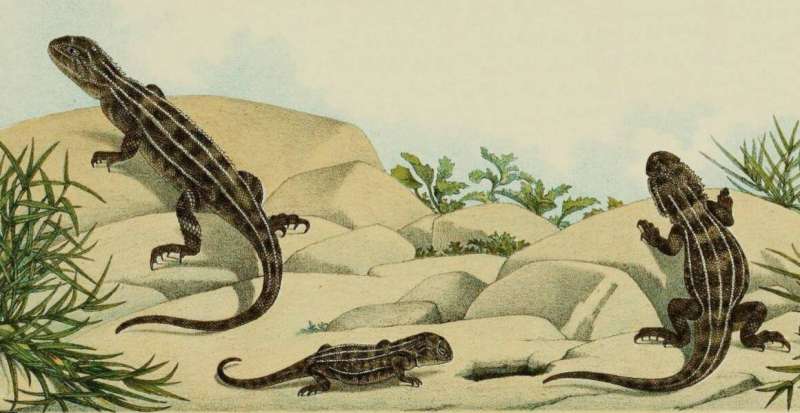This article has been reviewed according to Science X's editorial process and policies. Editors have highlighted the following attributes while ensuring the content's credibility:
fact-checked
trusted source
proofread
Australian lizard species rediscovered following extinction fears

A rare lizard has been rediscovered 50 years after it was last seen.
Had it become extinct, the Victorian grassland earless dragon would have been the first known reptile from mainland Australia to have been lost. Its rediscovery gives a second chance to help it avoid this fate.
It's not a myth: this Australian dragon is very much alive.
Having not been seen since 1969, there were concerns that the Victorian grassland earless dragon was extinct. The expansion of Melbourne, the state capital of Victoria, as well as the spread of invasive predators like foxes and cats, were thought to have wiped the species out.
However, renewed searches of its former habitat have revealed that the dragon is still alive and well. While its exact location is being kept secret, efforts are already underway to work out how best to help the reptile recover.
Ingrid Stitt, the state of Victoria's Minister for the Environment, says, "This is an amazing discovery and offers an opportunity for us to recover a species once thought lost to our state and the world.
"With the help of our partners we will continue to fight the extinction of this Critically Endangered species, ensuring future generations can see and learn about this incredibly unique lizard."
What threats does this lizard face?
Like many native Australian species, the Victorian grassland earless dragon hasn't fared well with the changes to Australia's ecosystems in the past few hundred years.
Some of the most major changes have come about because of the introduction of invasive species. Cats, for instance, were introduced as pets by European settlers in the late 1700s, giving rise to large feral populations that consume around 240 million native Australian animals every year.
Despite living in spider burrows and having rows of spiky scales along its body, the dragon has not been safe from these predators, which have driven its population down.
At the same time, Australia has become increasingly more urban. The growth of cities such as Melbourne means that just 1% of the grassland that the dragon used to call home remains, with those sites in areas that are likely to be developed in the coming years.
Despite these pressures, however, concern over the fate of the species wasn't perhaps as high as it should be. This is because the species was conflated with two close relatives that lived elsewhere, so its population wasn't thought to have been as perilously low as it actually was.
In 2019, a study revealed that the Victorian grassland earless dragon was a species in its own right, more formally known as Tympanocryptis pinguicolla. With surveys at the sites of unconfirmed sightings in 1988 and 1990 having drawn blanks, it highlighted the need for urgent work to better understand these reptiles.
Importantly, it noted that while the species was certainly at risk of extinction, it couldn't be declared extinct until all potential habitats had been checked. Four years later, these surveys have finally resulted in the lizard's rediscovery.
Supporting Australia's threatened wildlife
Rediscovering an extinct Australian species isn't entirely unprecedented. Leadbeater's possum, a mammal found only in Victoria's highlands, was rediscovered in the 1960s after being presumed lost in the early twentieth century.
However, the possum remains Critically Endangered despite over 60 years of efforts to bolster its population. It's hoped that by moving quickly, the Victorian grassland earless dragon will be able to avoid the same issues.
The first step is to find out how many of the reptiles are left, with the Australian government investing just shy of A$100,000 to train sniffer dogs to seek them out.
Tanya Plibersek, Australia's Minister for the Environment and Water, says, "It's such exciting news that the Victorian grassland earless dragon has been rediscovered, and it's a reminder about why it's so important to invest in habitat restoration and the eradication of feral species like cats and foxes."
"To best support the recovery of the Victorian grassland earless dragon, we have to know where they are. Detection dogs are an effective and non-invasive way to find this highly cryptic and critically endangered lizard in the wild."
Meanwhile, Zoos Victoria is set to establish a captive breeding program for the animals in the hope that they can boost the dragon's wild population, amid the development of a wider species recovery plan.
In this, the dragon follows in the footsteps of two other Australian reptiles, the Christmas Island blue-tailed skink and the Christmas Island chained gecko, both of which come from the territory which gives them their name.
Their numbers have risen after being taken into captivity to prevent them going the same way as the Christmas Island whiptail-skink, which was wiped out by invasive species.
By taking proactive action, it's hoped that Australia's unique and fragile biodiversity will be better able to tolerate challenges in the years to come.
Provided by Natural History Museum
This story is republished courtesy of Natural History Museum. Read the original story here.
















